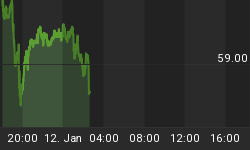When the market closed on Thursday of this week, it left most U.S. equity indices near the middle of this year's range without an obvious statement about where they would go next. A trend-following trader probably would see bullish signals, with the Russell 2000 and S&P midcap indices showing the greatest upward momentum and the most unambiguous series of higher lows and higher highs. The same trader might see the recent sideways movement in the NASDAQ 100, the S&P 500 and the S&P 100 as corrections that would precede another rally.
To the trend-following trader, we strongly advise caution. Although we cannot rule out the prospect of marginally higher highs in the major indices this spring, all of the U.S. indices we follow have used the past month either to form possible terminal patterns or to trace out what may be the beginning of a decline. While it is extraordinarily difficult to call a precise market top without the benefit of hindsight, it is important to note that this is how market tops typically form. Each index finds its own way to produce a completed pattern, usually within a few weeks or months of the other indices doing the same, and the ending patterns do not all look alike. The NASDAQ 100 Index (NDX) offers an example an index that may have already put in a top, and it is presently forming a pattern that is consistent with the start of a downward trend.
To put the NDX charts in context, we view the entire decade-long climb from the index's low in 2002 to the present high as a three-wave corrective pattern. In 2008, with the market crash, NDX actually made a higher low compared to 2002, leading us to label the decline as a B wave. The advance since 2008 can be counted as a five-wave impulsive move, as befits the C wave of an A-B-C correction.
As is common, the middle wave [iii] of the big advance was the strongest. The monthly chart below shows how correct fork placement highlights the key Elliott wave assignments of the internal moves in wave [iii]. In particular, note how the internal sub-wave (iv) reached down to test the lower boundary of the channel. That is typical fourth-wave behavior.

After the completion of wave [iii], NDX has made a relatively quick pair of downward and upward moves that meet the requirements for a completed wave [iv] and a developing wave [v]. Those moves can be seen more clearly on a weekly chart. The question now is whether wave [v] is complete. We believe there is adequate evidence in the pattern to say it probably is complete and that the marginally lower high of March 20 probably represents the start of a downward trend. While it is still too early to be certain that the trend has changed, this is an area where trend-following traders must be cautious about bullish expectations.

Counting downward from the March 2 high on a daily chart, the first swing appears impulsive, consistent with the beginning of a new trend. The index then made what appears to be a three-wave correction upward to form a lower high later in March. The action since that time also is consistent with a setup for lower prices.
We will follow this and other indices closely next week to look for signs that confirm or invalidate this conclusion. A decline in the index to the area around 4,150 would serve as initial confirmation of the downward scenario. Follow us on Twitter for updates as the pattern develops.
Also, our next eBook will present charts and analysis for this and six other major U.S. equity indices as well as treasury bonds. It will be available in early April through our website and at Amazon.

















